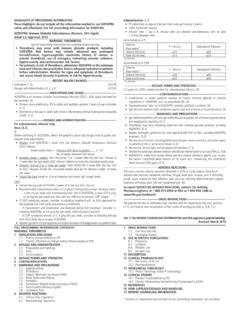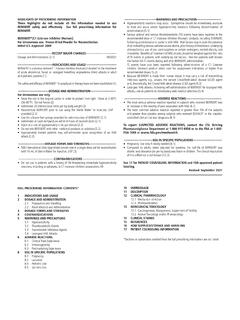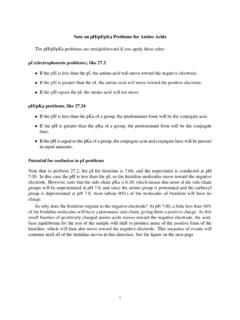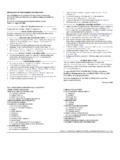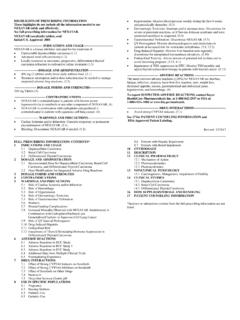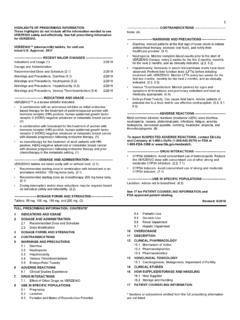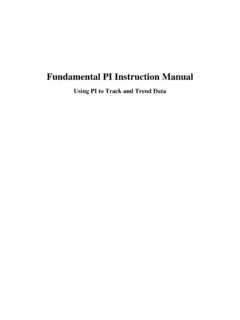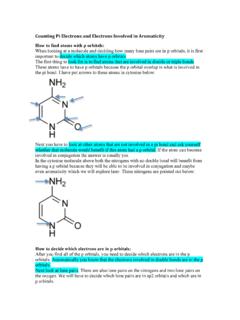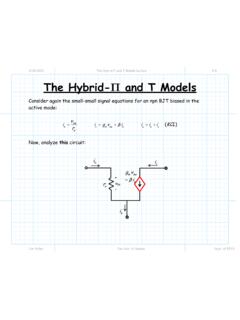Transcription of (2.3) • PI: Administer at regular intervals from daily up ...
1 FULL prescribing information : CONTENTS*WARNING: THROMBOSIS1 INDICATIONS AND USAGE Primary Immunodeficiency (PI) Chronic Inflammatory Demyelinating Polyneuropathy (CIDP)2 DOSAGE AND ADMINISTRATION Preparation and Handling Dose Administration3 DOSAGE FORMS AND STRENGTHS4 CONTRAINDICATIONS5 WARNINGS AND PRECAUTIONS Hypersensitivity Thrombosis Aseptic Meningitis Syndrome (AMS) Renal Dysfunction/Failure Hemolysis Transfusion Related Acute Lung Injury (TRALI) Transmissible Infectious Agents Laboratory Tests6 ADVERSE REACTIONS Clinical Trials Experience Postmarketing Experience7 DRUG INTERACTIONS Live Virus Vaccines Serological Testing8 USE IN SPECIFIC POPULATIONS Pregnancy Lactation Pediatric Use Geriatric Use11 DESCRIPTION12 CLINICAL PHARMACOLOGY Mechanism of Action Pharmacokinetics13 NONCLINICAL TOXICOLOGY Animal Toxicology and/or Pharmacology14 CLINICAL STUDIES Primary Immunodeficiency (PI) Chronic Inflammatory Demyelinating Polyneuropathy (CIDP)
2 15 REFERENCES16 HOW SUPPLIED/STORAGE AND HANDLING17 PATIENT COUNSELING information * Sections or subsections omitted from the full prescribing information are not OF prescribing INFORMATIONT hese highlights do not include all the information needed to use HIZENTRA safely and effectively. See full prescribing information for , Immune Globulin Subcutaneous (Human), 20% LiquidInitial Approval: 2010 WARNING: THROMBOSISSee full prescribing information for complete boxed warning. Thrombosis may occur with immune globulin products, including HIZENTRA. Risk factors may include: advanced age, prolonged immobilization, hypercoagulable conditions, history of venous or arterial thrombosis, use of estrogens, indwelling vascular catheters, hyperviscosity, and cardiovascular risk factors.
3 For patients at risk of thrombosis, Administer HIZENTRA at the minimum dose and infusion rate practicable. Ensure adequate hydration in patients before administration. Monitor for signs and symptoms of thrombosis and assess blood viscosity in patients at risk for MAJOR CHANGES------------------------------Ind ications ( ) 3/2018 Dosage and Administration ( , ) 3/2018---------------------------------- --INDICATIONS AND USAGE---------------------------------HI ZENTRA is an Immune Globulin Subcutaneous (Human) (IGSC), 20% Liquid indicated for the treatment of: Primary immunodeficiency (PI) in adults and pediatric patients 2 years of age and older. ( ) Maintenance therapy in adults with chronic inflammatory demyelinating polyneuropathy (CIDP). ( )------------------------------DOSAGE AND ADMINISTRATION-------------------------- -----For subcutaneous infusion ( )PIBefore switching to HIZENTRA, obtain the patient s serum IgG trough level to guide sub-sequent dose adjustments.
4 Weekly: Start HIZENTRA 1 week after last Immune Globulin Intravenous (Human) (IGIV) infusion. Initial weekly dose = Previous IGIV dose (in grams) x No. of weeks between IGIV doses Biweekly (every 2 weeks): Start HIZENTRA 1 or 2 weeks after the last IGIV infusion or 1 week after the last weekly IGSC infusion. Administer twice the calculated weekly dose. Frequent dosing (2 to 7 times per week): Start HIZENTRA 1 week after the last IGIV or IGSC infusion. Divide the calculated weekly dose by the desired number of times per week. Adjust the dose based on clinical response and serum IgG trough Initiate therapy with HIZENTRA 1 week after the last IGIV infusion. Recommended subcutaneous dose is g/kg (1 mL/kg) body weight (bw) per In the clinical study after transitioning from IGIV to HIZENTRA, a dose of g/kg (2 mL/kg) bw per week was also safe and effective to prevent CIDP relapse.
5 If CIDP symptoms worsen, consider re-initiating treatment with an IGIV approved for the treatment of CIDP, while discontinuing HIZENTRA. - If improvement and stabilization are observed during IGIV treatment, consider re-initiating HIZENTRA at g/kg bw per week, while discontinuing If CIDP symptoms worsen on g/kg bw per week, consider re-initiating therapy with IGIV, while discontinuing HIZENTRA. Monitor patient s clinical response and adjust duration of therapy based on patient ( ) PI: Administer at regular intervals from daily up to every 2 weeks. CIDP: Administer weekly. Infusion sites Up to 8 infusion sites are allowed simultaneously, with at least 2 inches between in PIInfusion Parameters*1st InfusionSubsequent InfusionsVolume (mL/site) 15 25 Rate (mL/hr/site) 15 25*As toleratedAdministration in CIDPI nfusion Parameters*1st InfusionSubsequent InfusionsVolume (mL/site) 20 50 Rate (mL/hr/site) 20 50* As tolerated----------------------------DOS AGE FORMS AND g per mL (20%) protein solution for subcutaneous infusion.
6 (3)------------------------------------- CONTRAINDICATIONS----------------------- --------------- Anaphylactic or severe systemic reaction to human immune globulin or inactive ingredients of HIZENTRA, such as polysorbate 80. (4) Hyperprolinemia Type I or II (HIZENTRA contains stabilizer L-proline). (4) IgA-deficient patients with antibodies against IgA and a history of hypersensitivity. (4)---------------------------------WARN INGS AND PRECAUTIONS---------------------------- IgA-deficient patients with anti-IgA antibodies are at greater risk of severe hypersensitivity and anaphylactic reactions. ( ) Thrombosis may occur following treatment with immune globulin products, including HIZENTRA. ( ) Aseptic meningitis syndrome has been reported with IGIV or IGSC, including HIZENTRA treatment.
7 ( ) Monitor renal function, including blood urea nitrogen, serum creatinine, and urine output in patients at risk of acute renal failure. ( ) Monitor for clinical signs and symptoms of hemolysis. ( ) Monitor for pulmonary adverse reactions (transfusion-related acute lung injury [TRALI]). ( ) HIZENTRA is made from human blood and may contain infectious agents, , viruses, the variant Creutzfeldt-Jakob disease (vCJD) agent and, theoretically, the Creutzfeldt-Jakob disease (CJD) agent. ( )-----------------------------------ADVE RSE REACTIONS------------------------------- ---------The most common adverse reactions observed in 5% of study subjects were local infusion site reactions, headache, diarrhea, fatigue, back pain, nausea, pain in extremity, cough, upper respiratory tract infection, rash, pruritus, vomiting, abdominal pain (upper), migraine, arthralgia, pain, fall and nasopharyngitis.
8 (6)To report SUSPECTED ADVERSE REACTIONS, contact CSL Behring Pharmacovigilance at 1-866-915-6958 or FDA at 1-800-FDA-1088 INTERACTIONS---------------------------- -----------The passive transfer of antibodies may interfere with the response to live virus vaccines ( ), and lead to misinterpretation of the results of serological testing. ( , )See 17 for PATIENT COUNSELING information and FDA-approved patient : March 2018 Hizentra Immune Globulin Subcutaneous (Human) (IGSC), 20% LiquidFULL prescribing INFORMATIONWARNING: THROMBOSIS Thrombosis may occur with immune globulin products13, including HIZENTRA. Risk factors may include: advanced age, prolonged immobilization, hypercoagulable conditions, history of venous or arterial thrombosis, use of estrogens, indwelling central vascular catheters, hyperviscosity, and cardiovascular risk factors.
9 Thrombosis may occur in the absence of known risk factors [see Warnings and Precautions ( ), and Patient Counseling information (17). For patients at risk of thrombosis, Administer HIZENTRA at the minimum dose and infusion rate practicable. Ensure adequate hydration in patients before administration. Monitor for signs and symptoms of thrombosis and assess blood viscosity in patients at risk for hyperviscosity [see Warnings and Precautions ( )].1 INDICATIONS AND USAGEHIZENTRA is an Immune Globulin Subcutaneous (Human) (IGSC), 20% Liquid indicated for the treatment of the following Primary Immunodeficiency (PI)HIZENTRA is indicated as replacement therapy for primary humoral immunodeficiency (PI) in adults and pediatric patients 2 years of age and older. This includes, but is not limited to, the humoral immune defect in congenital agammaglobulinemia, common variable immunodeficiency, X-linked agammaglobulinemia, Wiskott-Aldrich syndrome, and severe combined Chronic Inflammatory Demyelinating Polyneuropathy (CIDP)HIZENTRA is indicated for the treatment of adult patients with chronic inflammatory demyelinating polyneuropathy (CIDP) as maintenance therapy to prevent relapse of neuromuscular disability and of Use:HIZENTRA maintenance therapy in CIDP has been systematically studied for 6 months and for a further 12 months in a follow-up study.]
10 Maintenance therapy beyond these periods should be individualized based upon the patient s response and need for continued therapy [see Dosage and Administration (2)].2 DOSAGE AND ADMINISTRATIONFor subcutaneous infusion Preparation and HandlingHIZENTRA is a clear and pale yellow to light brown solution. Do not use if the solution is cloudy or contains particulates. Prior to administration, visually inspect each vial of HIZENTRA for particulate matter or discoloration, whenever the solution and container permit. Do not freeze. Do not use any solution that has been frozen. Check the product expiration date on the vial label. Do not use beyond the expiration date. Do not mix HIZENTRA with other products. Do not shake the vial. Use aseptic technique when preparing and administering this product.


